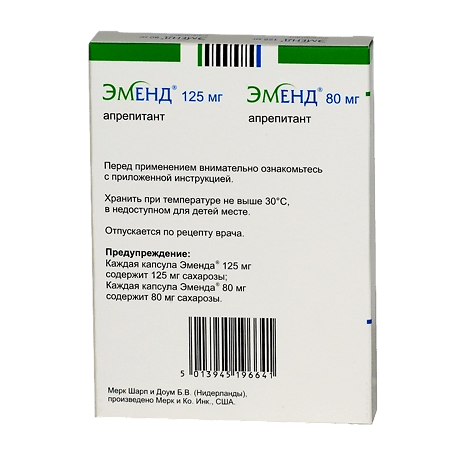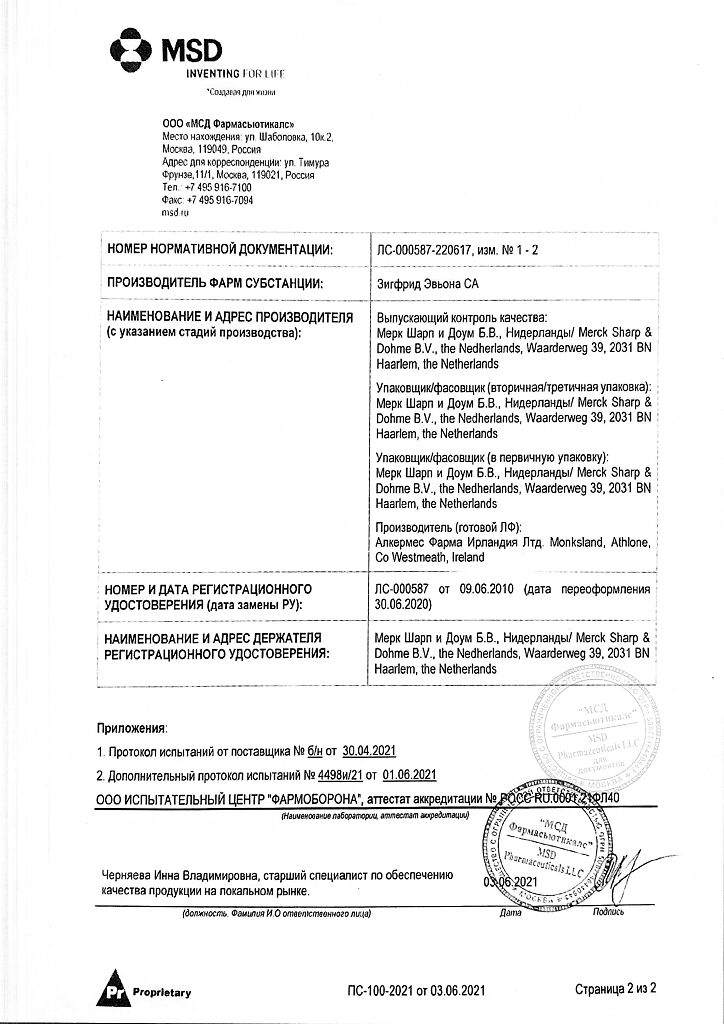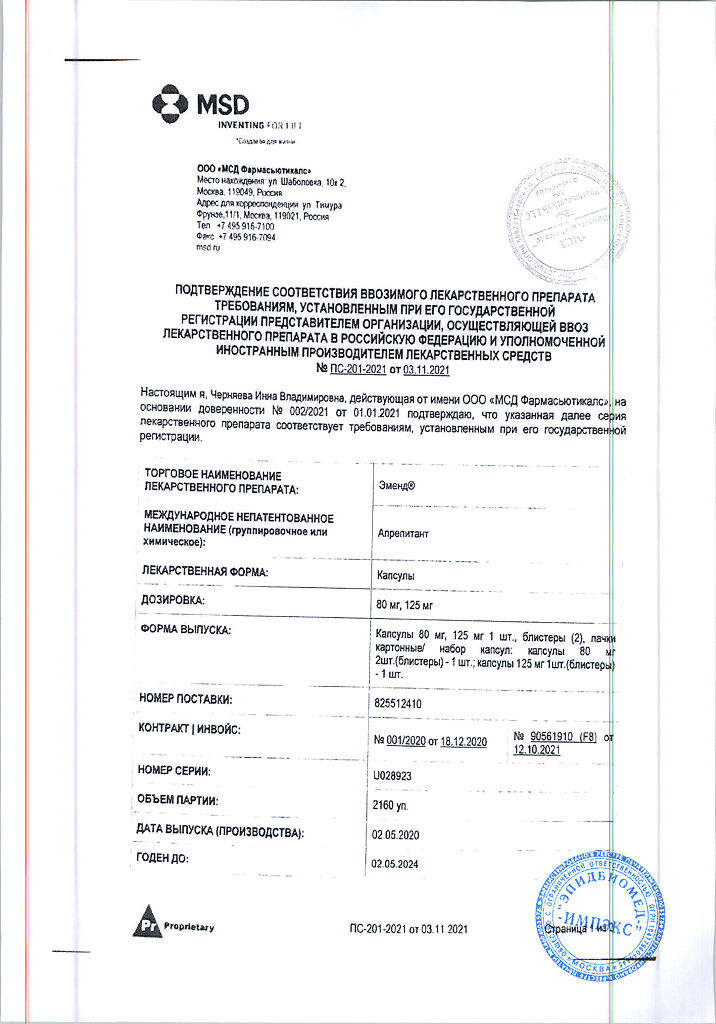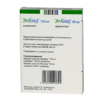No products in the cart.
Emend kit, 125 mg+80 mg capsules 3 pcs
€174.80 €145.67
Description
Pharmacodynamics
An anti-emetic drug, a selective high-affinity neurokinin-1 (NK1 receptor antagonist of Substance P. The selectivity of aprepitant binding to NK1 receptors is at least 3,000 times higher than for other enzymes, ion channel transporters and receptor sites, including dopamine and serotonin receptors, which are the targets of currently available drugs used to treat chemotherapy-related nausea and vomiting.
In preclinical studies, NK1 receptor antagonists have been shown to prevent the development of vomiting caused by chemotherapy drugs (such as cisplatin) through a central mechanism of action.
The aprepitant penetrates the brain and binds to brain NK1 receptors. With its long-lasting central action, aprepitant inhibits both the acute and delayed phases of cisplatin-induced vomiting and enhances the antiemetic effects of ondansetron and dexamethasone.
Pharmacokinetics
Intake
After oral administration, Cmax in plasma is reached after approximately 4 h. Absolute bioavailability on average is about 60-65%. Taking the capsule simultaneously with meals has no clinically significant effect on the bioavailability of aprepitant.
The pharmacokinetics of aprepitant in the clinical dose range is nonlinear.
After oral administration of Emend® at a dose of 125 mg on day 1 and then at a dose of 80 mg/day on days 2 and 3, the 24-hour AUC was approximately 19.5 µg×h/mL on day 1 and 20.1 µg×h/mL on day 3. Cmax was 1.5 µg/mL and 1.4 µg/mL on days 1 and 3, respectively, and was reached approximately 4 h after drug administration.
Distribution
The binding to plasma proteins is more than 95%. Vd in equilibrium is approximately 66 l.
In experimental studies, aprepitant has been shown to penetrate the placental barrier in rats and through the HEB in rats and ferrets.
In humans, aprepitant penetrates through the GEB.
Metabolism
. Aprepitant undergoes intensive metabolism in the liver through oxidation in the morpholine ring and its side chains mainly by CYP3A4 and only a small part of the drug is metabolized with the participation of CYP1A2 and CYP2C19 (CYP2D6, CYP2C9 or CYP2E1 are not involved in aprepitant metabolism).
Elevation
The estimated T1/2 is approximately 9 to 13 h.
The aprepitant is excreted primarily as metabolites through the intestine (86%) and the kidneys (5%).
The apparent plasma clearance of aprepitant is approximately 60 to 84 ml/min.
Pharmacokinetics in special clinical cases
The pharmacokinetics of Emend® in children and adolescents under 18 years of age have not been studied.
In patients 65 years of age and older, after oral administration of Emend® at a single dose of 125 mg on day 1 and then at a dose of 80 mg/day on days 2 and 5, the 24-hour AUC was 21% greater on day 1 and 36% greater on day 5 than in those younger than 65 years. Cmax was 10% higher on day 1 and 24% higher on day 5. These differences were not clinically significant.
In patients with mild hepatic impairment (5-6 points on the Child-Pugh scale) after oral administration of Emend® at a dose of 125 mg on day 1 and then at a dose of 80 mg/day on days 2 and 3, AUC within 24 hours was 11% lower on day 1 and 36% lower on day 3 than in healthy volunteers who received the same doses of the drug. In patients with moderate hepatic impairment (7-9 Child-Pugh scores), the 24-hour AUC was 10% greater on day 1 and 18% greater on day 3 than in healthy volunteers who received the same doses. These differences were not found to be clinically significant.
Patients with severe renal impairment (CK < 30 ml/min) and terminal renal failure patients requiring hemodialysis received Emend® once at a dose of 240 mg. In patients with severe renal failure, the AUC for total aprepitant (both protein bound and unbound) was reduced by 21% and Cmax was reduced by 32% compared to healthy volunteers. In patients with terminal renal failure who were on hemodialysis, the AUC for total aprepitant was 42% lower and Cmax was 32% lower. Because of the slight decrease in binding of aprepitant to plasma proteins in patients with renal failure, the AUC values of the pharmacologically active unbound drug were not significantly different in these patients and in healthy subjects. Hemodialysis performed 4 and 48 h after drug administration had no significant effect on the pharmacokinetics of aprepitant. Less than 0.2% of the aprepitant dose was detected in the dialysate.
The AUC0-24 and Cmax of the drug were 9% and 17% higher in women than in men after a single oral dose of Emend®, respectively. T1/2 aprepitant in women was 25% less than in men, and there were no significant differences in time to reach Cmax between women and men. These differences in pharmacokinetic parameters have no clinical significance. There is no need to adjust the dose of Emend® depending on the race. Body mass index has no effect on the pharmacokinetics of Emend®.
Indications
Indications
To prevent acute and delayed nausea and vomiting caused by highly or moderately emetogenic anticancer drugs (in combination with other antiemetic drugs).
Pharmacological effect
Pharmacological effect
Pharmacodynamics
An antiemetic drug, a selective high-affinity antagonist of substance P neurokinin-1 (NK1) receptors. The binding selectivity of aprepitant at NK1 receptors is at least 3000 times greater than for other enzymes, ion channel transporters and receptor sites, including dopamine and serotonin receptors, which are the targets of current drugs used to treat nausea and vomiting associated with chemotherapy.
In preclinical studies, NK1 receptor antagonists have been shown to prevent emesis caused by chemotherapy drugs (eg, cisplatin) through a central mechanism of action.
Aprepitant enters the brain and binds to brain NK1 receptors. Having a long-lasting central effect, aprepitant inhibits both the acute and delayed phases of vomiting caused by cisplatin, and also enhances the antiemetic effect of ondansetron and dexamethasone.
Pharmacokinetics
Suction
After oral administration, Cmax in blood plasma is reached in approximately 4 hours. Absolute bioavailability averages about 60-65%. Taking the capsule with food does not have a clinically significant effect on the bioavailability of aprepitant.
The pharmacokinetics of aprepitant over the clinical dose range is nonlinear.
After oral administration of Emend® at a dose of 125 mg on day 1 and then at a dose of 80 mg/day on days 2 and 3, the AUC over 24 hours was approximately 19.5 mcg x h/ml on day 1 and 20.1 mcg x h/ml on day 3. Cmax was 1.5 mcg/ml and 1.4 mcg/ml on days 1 and 3, respectively, and was achieved approximately 4 hours after dosing.
Distribution
Plasma protein binding is more than 95%. Vd at equilibrium is approximately 66 l.
Experimental studies have shown that aprepitant penetrates the placental barrier in rats and the blood-brain barrier in rats and ferrets.
In humans, aprepitant crosses the blood-brain barrier.
Metabolism
Aprepitant is extensively metabolized in the liver through oxidation at the morpholine ring and its side chains, primarily by CYP3A4, and only a small portion of the drug is metabolized by CYP1A2 and CYP2C19 (CYP2D6, CYP2C9, or CYP2E1 are not involved in the metabolism of aprepitant).
Removal
Apparent T1/2 is approximately 9 to 13 hours.
Aprepitant is eliminated primarily as metabolites through the intestine (86%) and kidneys (5%).
The apparent plasma clearance of aprepitant is approximately 60 to 84 mL/min.
Pharmacokinetics in special clinical situations
The pharmacokinetics of Emend® in children and adolescents under 18 years of age has not been studied.
In patients aged 65 years and older, after oral administration of Emend® at a single dose of 125 mg on day 1 and then at a dose of 80 mg/day on days 2 and 5, the AUC over 24 hours was 21% greater on day 1 and 36% greater on day 5 than in individuals under 65 years of age. Cmax was 10% higher on the 1st day and 24% higher on the 5th day. These differences were not clinically significant.
In patients with mild hepatic impairment (Child-Pugh score 5-6), after oral administration of Emend® at a dose of 125 mg on day 1 and then at a dose of 80 mg/day on days 2 and 3, the AUC over 24 hours was 11% less on day 1 and 36% less on day 3 than in healthy volunteers who received the same doses of the drug. In patients with moderate hepatic impairment (Child-Pugh score 7-9), AUC over 24 hours was 10% greater on day 1 and 18% greater on day 3 than in healthy volunteers receiving the same doses. These differences were not considered clinically significant.
Patients with severe renal failure (creatinine clearance <30 ml/min) and patients in end-stage renal failure requiring hemodialysis received Emend® at a single dose of 240 mg. In patients with severe renal impairment, the AUC for total aprepitant (both protein bound and non-protein bound) was reduced by 21% and Cmax was reduced by 32% compared to healthy subjects. In patients with end-stage renal disease on hemodialysis, the AUC for total aprepitant was 42% lower and the Cmax was 32% lower. Due to the slight decrease in plasma protein binding of aprepitant in patients with renal impairment, the AUC values of the pharmacologically active unbound drug were not significantly different between these patients and healthy subjects. Hemodialysis performed 4 and 48 hours after dosing did not have a significant effect on the pharmacokinetics of aprepitant. Less than 0.2% of the aprepitant dose was detectable in the dialysate.
After a single oral dose of Emend®, the AUC0-24 and Cmax of the drug in women were 9% and 17% higher, respectively, than in men. T1/2 of aprepitant in women was 25% less than in men, and there were no significant differences in the time to reach Cmax between women and men. These differences in pharmacokinetic parameters are not clinically significant. No dose adjustment of Emend® is required depending on race. Body mass index does not affect the pharmacokinetics of aprepitant.
Special instructions
Special instructions
Inhibition of CYP3A4 by aprepitant may result in increased plasma concentrations of drugs that are primarily metabolized by CYP3A4 (including some chemotherapy drugs).
Use in pediatrics
The safety and effectiveness of Emend® in children have not been established.
Impact on the ability to drive vehicles and other mechanisms that require increased concentration
No studies have been conducted to study the effect of Emend® on the ability to drive vehicles or operate machinery. However, the side effect profile of the drug should be taken into account, which may affect patients’ ability to operate machines. Patients may have different reactions to Emend®.
Active ingredient
Active ingredient
Aprepitant
Composition
Composition
1 capsule contains:
Active ingredient:
aprepitant 125 mg.
Excipients:
hydroxypropylcellulose,
sodium lauryl sulfate,
sucrose,
microcrystalline cellulose;
Capsule composition:
titanium dioxide, gelatin; 125 mg capsules also contain iron oxide yellow and iron oxide red.
There are 3 capsules in the blister.
There is 1 blister in a cardboard package.
Pregnancy
Pregnancy
Adequate and strictly controlled clinical studies of the safety of the drug during pregnancy have not been conducted, therefore the use of Emend® during pregnancy is not recommended.
It is not known whether aprepitant is excreted into breast milk in humans.
If it is necessary to use the drug during lactation, the issue of stopping breastfeeding should be decided due to the risk of undesirable effects on the infant.
Contraindications
Contraindications
Severe liver failure (> 9 points on the Child-Pugh scale);
simultaneous use with pimozide, terfenadine, astemizole and cisapride;
hypersensitivity to the components of the drug.
Caution: Emend should be used in patients concomitantly receiving medications that are metabolized primarily by the CYP3A4 isoenzyme. Co-administration of Emend® with warfarin can lead to a clinically significant decrease in INR. In patients receiving long-term warfarin therapy, the INR value should be carefully monitored for 2 weeks with each chemotherapy cycle and especially 7-10 days after starting the 3-day regimen of Emend. The effectiveness of hormonal contraceptives may be reduced during and for 28 days after treatment with Emend®. During treatment with Emend® and for 1 month after the last dose of Emend®, alternative and back-up methods of contraception should be used.
Side Effects
Side Effects
The safety of aprepitant was assessed in approximately 6500 patients.
Preventing nausea and vomiting caused by chemotherapy
Highly emetogenic therapy
The clinical trial included 544 patients who received highly emetogenic therapy and aprepitant in the first cycle. 413 patients from this group continued therapy (maximum number of chemotherapy courses – 6). The three-day regimen of Emend® in combination with ondansetron and dexamethasone was well tolerated by patients. The majority of adverse reactions recorded in clinical studies were defined as mild to moderate reactions.
The most common adverse reactions during highly emetogenic chemotherapy in patients receiving aprepitant in combination with serotonin 5-HT3 receptor antagonists and dexamethasone (observed with a higher frequency than during therapy with serotonin 5-HT3 receptor antagonists and dexamethasone): hiccups (4.6%), increased ALT activity (2.8%), dyspepsia (2.6%), constipation (2.4%), headache (2%) and decreased appetite (2%).
In an additional clinical study of 1169 patients receiving different types of highly emetogenic chemotherapy and anti-nausea and vomiting regimens using aprepitant and serotonin 5-HT3 receptor antagonists and dexamethasone, or only serotonin 5-HT3 receptor antagonists and dexamethasone, the adverse reaction profile was similar.
Moderately emetogenic therapy
In a clinical study of 868 patients, the most common adverse reaction to moderately emetogenic chemotherapy in patients receiving aprepitant in combination with 5-HT3 receptor antagonists and dexamethasone (occurring at a higher rate than with 5-HT3 receptor antagonists and dexamethasone) was fatigue (1.4%).
In a pooled analysis of studies of highly emetogenic and moderately emetogenic chemotherapy, the following drug-related side effects were observed in patients treated with aprepitant at a higher incidence than with standard therapy:
often (from ≥1/100 to <1/10); uncommon (from ≥1/1000 to <1/100); rare (from ≥1/10,000 to <1/1000).
Infectious and parasitic diseases: rarely – candidiasis, staphylococcal infection.
From the hematopoietic system: infrequently – anemia, febrile neutropenia.
From the side of metabolism and nutrition: often – loss of appetite; rarely – polydipsia.
Mental disorders: infrequently – anxiety; rarely – disorientation, euphoria.
From the nervous system: infrequently – dizziness, drowsiness; rarely – cognitive impairment, lethargy, perversion of taste.
From the senses: rarely – conjunctivitis, tinnitus.
From the cardiovascular system: infrequently – rapid heartbeat, paroxysmal sensations of heat (“hot flashes”); rarely – bradycardia, cardiovascular disorders.
From the respiratory system: often – hiccups; rarely – sore throat, sneezing, cough, postnasal drip, pharyngeal irritation.
From the digestive system: often – dyspepsia; uncommon – belching, nausea, gastroesophageal reflux, vomiting, abdominal pain, dry mouth, flatulence; rarely – hard feces, perforated duodenal ulcer, neutropenic colitis, stomatitis, bloating.
From the skin and subcutaneous fat: infrequently – rash, acne; rarely – photosensitivity, increased sweating, seborrhea, increased skin oiliness, itchy rash.
From the musculoskeletal system: rarely – muscle spasms, muscle weakness.
From the urinary system: infrequently – dysuria; rarely – pollakiuria.
Changes in laboratory parameters: often – increased ALT activity; infrequently – increased AST activity, increased alkaline phosphatase activity; rarely – increased diuresis, the presence of red blood cells in the urine, hyponatremia, decreased body weight, glucosuria, neutropenia.
General disorders: often – fatigue; infrequently – asthenia, malaise; rarely – swelling, discomfort in the chest area, gait disturbance.
The side effect profile in patients receiving highly emetogenic and moderately emetogenic chemotherapy during repeated courses (maximum number of courses – 6) with aprepitant was comparable to that during the 1st cycle of chemotherapy.
In another study of aprepitant for the prevention of chemotherapy-induced nausea and vomiting, serious side effects such as Stevens-Johnson syndrome and toxic epidermal necrolysis (Lyell’s syndrome) were reported.
Data from post-registration studies
Due to the fact that the reports came from volunteers from populations of unknown size, it is not possible to reliably determine the expected frequency or causal relationship with the drug.
From the skin and skin appendages: itching, rash, urticaria, rarely – Stevens-Johnson syndrome, toxic epidermal necrolysis (Lyell’s syndrome).
From the immune system: hypersensitivity reactions, including anaphylactic reactions.
Interaction
Interaction
Aprepitant is a substrate, moderate inhibitor and inducer of CYP3A4, and an inducer of CYP2C9.
When administered concomitantly, aprepitant may increase the plasma concentrations of drugs metabolized by the CYP3A4 isoenzyme. Emend® should not be used simultaneously with pimozide, terfenadine, astemizole, cisapride, ergot alkaloid derivatives. Inhibition of CYP3A4 by aprepitant may result in increased plasma concentrations of these drugs and potentially serious and life-threatening reactions.
Aprepitant induces the metabolism of warfarin and tolbutamide. Co-administration of Emend® with these or other drugs that are metabolized by the CYP2C9 isoenzyme (for example, with phenytoin) may lead to a decrease in their plasma concentrations. There was no effect of Emend® on the AUC of R(+)- or S(-)-warfarin, however, when used together, a decrease in the minimum concentration of S(-)-warfarin was observed, which was accompanied by a decrease in INR by 14% 5 days after the end of taking Emend®.
In patients receiving long-term warfarin therapy, INR levels should be carefully monitored for 2 weeks, and especially 7-10 days after starting the 3-day regimen of Emend, during each chemotherapy cycle.
Emend® reduces the AUC of tolbutamide, which is a substrate of the CYP2C9 isoenzyme, by 23% on day 4, by 28% on day 8 and by 15% on day 15. In this case, tolbutamide in a single dose of 500 mg was prescribed before the start of a 3-day treatment regimen with Emend® on days 4, 8 and 15.
Interaction of the drug Emend® with drugs that are substrates of the P-glycoprotein transporter is unlikely (no interaction of the drug Emend® with digoxin). Aprepitant does not cause clinically significant changes in the pharmacokinetics of the serotonin 5HT3 receptor antagonists ondansetron, granisetron and hydrodolasetron (the active metabolite of dolasetron).
With the simultaneous use of the drug Emend® and GCS, an increase in the AUC of dexamethasone (when taken orally) was noted by 2.2 times, methylprednisolone administered intravenously by 1.3 times, and methylprednisolone taken orally by 2.5 times. In this regard, to achieve the desired effect, the standard dose of dexamethasone when taken orally in combination with aprepitant is reduced by 50%, methylprednisolone when administered intravenously is reduced by approximately 25%, when administered orally – by 50%.
When using Emend® together with chemotherapeutic drugs, the metabolism of which occurs mainly or partially with the participation of the CYP3A4 isoenzyme (etoposide, vinorelbine, docetaxel and paclitaxel), the doses of these drugs do not need to be adjusted. However, caution and additional monitoring are recommended when used in patients receiving these drugs. Cases of neurotoxicity have been reported in post-marketing studies and may be considered a possible side effect of ifosfamide when used in conjunction with aprepitant.
The effect of Emend® on the pharmacokinetics of docetaxel has not been identified.
The effectiveness of hormonal contraceptives during use and for 28 days after stopping taking Emend® may be reduced (alternative or backup methods of contraception should be used during treatment with Emend® and for 1 month after taking the last dose of Emend®).
With simultaneous oral administration of midazolam and Emend®, an increase in the AUC of midazolam was observed. A possible increase in the plasma concentration of midazolam or other benzodiazepines, the metabolism of which is carried out with the participation of the CYP3A4 isoenzyme (alprazolam, triazolam), should be taken into account when prescribing these drugs simultaneously with Emend®.
Concomitant use of Emend® with drugs that inhibit the activity of the CYP3A4 isoenzyme may lead to increased plasma concentrations of aprepitant. Therefore, it is necessary to prescribe Emend® with caution in combination with strong inhibitors of the CYP3A4 isoenzyme (for example, with ketoconazole). However, co-administration of Emend with moderate inhibitors of the CYP3A4 isoenzyme (for example, diltiazem, itraconazole, voriconazole, posaconazole, clarithromycin, telithromycin and protease inhibitors) does not cause clinically significant changes in the concentration of aprepitant in the blood plasma.
Concomitant use of Emend® with drugs that are strong inducers of the CYP3A4 isoenzyme (for example, rifampicin, phenytoin, carbamazepine, phenobarbital) may lead to a decrease in the plasma concentration of aprepitant and, thus, a decrease in the effectiveness of Emend®. Also, the simultaneous use of aprepitant with St. John’s wort preparations is not recommended.
In patients with mild to moderate hypertension, administration of an aprepitant tablet containing a dose comparable to 230 mg capsules in combination with diltiazem 120 mg three times daily for 5 days resulted in a 2-fold increase in aprepitant AUC and a 1.7-fold increase in diltiazem AUC. These pharmacokinetic effects did not result in clinically significant changes in ECG, heart rate, or blood pressure compared with changes in these parameters when taking diltiazem alone.
Co-administration of aprepitant once daily in tablet form at a dose comparable to 85 mg or 170 mg capsules and paroxetine 20 mg once daily resulted in a decrease in AUC by approximately 25% and Cmax by approximately 20% for both aprepitant and paroxetine.
Overdose
Overdose
Symptoms: Available data on the use of aprepitant in high doses without chemotherapy (up to 600 mg once or 375 mg daily for 42 days) indicate that the drug is well tolerated. Somnolence and headache were observed in 1 patient who received 1440 mg of aprepitant.
Treatment: therapy with Emend® should be discontinued and the patient’s condition monitored. If necessary, carry out symptomatic therapy. Due to the antiemetic effects of aprepitant, drugs that induce vomiting are not likely to be effective. The antidote to the drug is unknown. Hemodialysis is not effective.
Storage conditions
Storage conditions
At a temperature not exceeding 30 °C
Shelf life
Shelf life
4 years
Manufacturer
Manufacturer
Merck Sharp and Dome B.V., The Netherlands
Additional information
| Shelf life | 4 years |
|---|---|
| Conditions of storage | At a temperature not exceeding 30 °C |
| Manufacturer | Merck Sharp & Doum B.V., The Netherlands |
| Medication form | capsules |
| Brand | Merck Sharp & Doum B.V. |
Related products
Buy Emend kit, 125 mg+80 mg capsules 3 pcs with delivery to USA, UK, Europe and over 120 other countries.





















